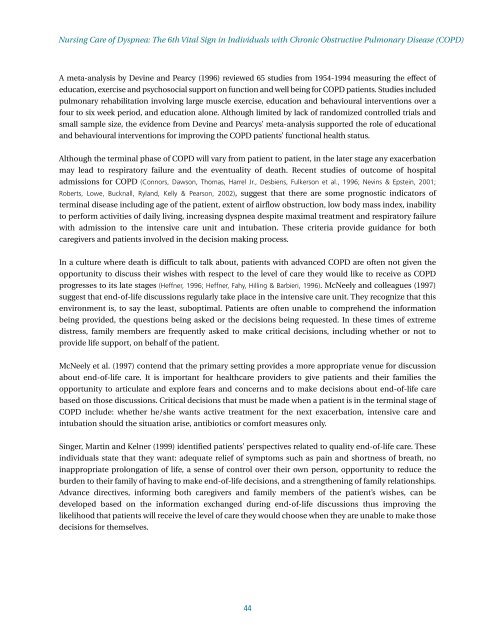Nursing Care of Dyspnea: The 6th Vital Sign in Individuals with ...
Nursing Care of Dyspnea: The 6th Vital Sign in Individuals with ...
Nursing Care of Dyspnea: The 6th Vital Sign in Individuals with ...
Create successful ePaper yourself
Turn your PDF publications into a flip-book with our unique Google optimized e-Paper software.
<strong>Nurs<strong>in</strong>g</strong> <strong>Care</strong> <strong>of</strong> <strong>Dyspnea</strong>: <strong>The</strong> <strong>6th</strong> <strong>Vital</strong> <strong>Sign</strong> <strong>in</strong> <strong>Individuals</strong> <strong>with</strong> Chronic Obstructive Pulmonary Disease (COPD)A meta-analysis by Dev<strong>in</strong>e and Pearcy (1996) reviewed 65 studies from 1954-1994 measur<strong>in</strong>g the effect <strong>of</strong>education, exercise and psychosocial support on function and well be<strong>in</strong>g for COPD patients. Studies <strong>in</strong>cludedpulmonary rehabilitation <strong>in</strong>volv<strong>in</strong>g large muscle exercise, education and behavioural <strong>in</strong>terventions over afour to six week period, and education alone. Although limited by lack <strong>of</strong> randomized controlled trials andsmall sample size, the evidence from Dev<strong>in</strong>e and Pearcys’ meta-analysis supported the role <strong>of</strong> educationaland behavioural <strong>in</strong>terventions for improv<strong>in</strong>g the COPD patients’ functional health status.Although the term<strong>in</strong>al phase <strong>of</strong> COPD will vary from patient to patient, <strong>in</strong> the later stage any exacerbationmay lead to respiratory failure and the eventuality <strong>of</strong> death. Recent studies <strong>of</strong> outcome <strong>of</strong> hospitaladmissions for COPD (Connors, Dawson, Thomas, Harrel Jr., Desbiens, Fulkerson et al., 1996; Nev<strong>in</strong>s & Epste<strong>in</strong>, 2001;Roberts, Lowe, Bucknall, Ryland, Kelly & Pearson, 2002), suggest that there are some prognostic <strong>in</strong>dicators <strong>of</strong>term<strong>in</strong>al disease <strong>in</strong>clud<strong>in</strong>g age <strong>of</strong> the patient, extent <strong>of</strong> airflow obstruction, low body mass <strong>in</strong>dex, <strong>in</strong>abilityto perform activities <strong>of</strong> daily liv<strong>in</strong>g, <strong>in</strong>creas<strong>in</strong>g dyspnea despite maximal treatment and respiratory failure<strong>with</strong> admission to the <strong>in</strong>tensive care unit and <strong>in</strong>tubation. <strong>The</strong>se criteria provide guidance for bothcaregivers and patients <strong>in</strong>volved <strong>in</strong> the decision mak<strong>in</strong>g process.In a culture where death is difficult to talk about, patients <strong>with</strong> advanced COPD are <strong>of</strong>ten not given theopportunity to discuss their wishes <strong>with</strong> respect to the level <strong>of</strong> care they would like to receive as COPDprogresses to its late stages (Heffner, 1996; Heffner, Fahy, Hill<strong>in</strong>g & Barbieri, 1996). McNeely and colleagues (1997)suggest that end-<strong>of</strong>-life discussions regularly take place <strong>in</strong> the <strong>in</strong>tensive care unit. <strong>The</strong>y recognize that thisenvironment is, to say the least, suboptimal. Patients are <strong>of</strong>ten unable to comprehend the <strong>in</strong>formationbe<strong>in</strong>g provided, the questions be<strong>in</strong>g asked or the decisions be<strong>in</strong>g requested. In these times <strong>of</strong> extremedistress, family members are frequently asked to make critical decisions, <strong>in</strong>clud<strong>in</strong>g whether or not toprovide life support, on behalf <strong>of</strong> the patient.McNeely et al. (1997) contend that the primary sett<strong>in</strong>g provides a more appropriate venue for discussionabout end-<strong>of</strong>-life care. It is important for healthcare providers to give patients and their families theopportunity to articulate and explore fears and concerns and to make decisions about end-<strong>of</strong>-life carebased on those discussions. Critical decisions that must be made when a patient is <strong>in</strong> the term<strong>in</strong>al stage <strong>of</strong>COPD <strong>in</strong>clude: whether he/she wants active treatment for the next exacerbation, <strong>in</strong>tensive care and<strong>in</strong>tubation should the situation arise, antibiotics or comfort measures only.S<strong>in</strong>ger, Mart<strong>in</strong> and Kelner (1999) identified patients’ perspectives related to quality end-<strong>of</strong>-life care. <strong>The</strong>se<strong>in</strong>dividuals state that they want: adequate relief <strong>of</strong> symptoms such as pa<strong>in</strong> and shortness <strong>of</strong> breath, no<strong>in</strong>appropriate prolongation <strong>of</strong> life, a sense <strong>of</strong> control over their own person, opportunity to reduce theburden to their family <strong>of</strong> hav<strong>in</strong>g to make end-<strong>of</strong>-life decisions, and a strengthen<strong>in</strong>g <strong>of</strong> family relationships.Advance directives, <strong>in</strong>form<strong>in</strong>g both caregivers and family members <strong>of</strong> the patient’s wishes, can bedeveloped based on the <strong>in</strong>formation exchanged dur<strong>in</strong>g end-<strong>of</strong>-life discussions thus improv<strong>in</strong>g thelikelihood that patients will receive the level <strong>of</strong> care they would choose when they are unable to make thosedecisions for themselves.44
















